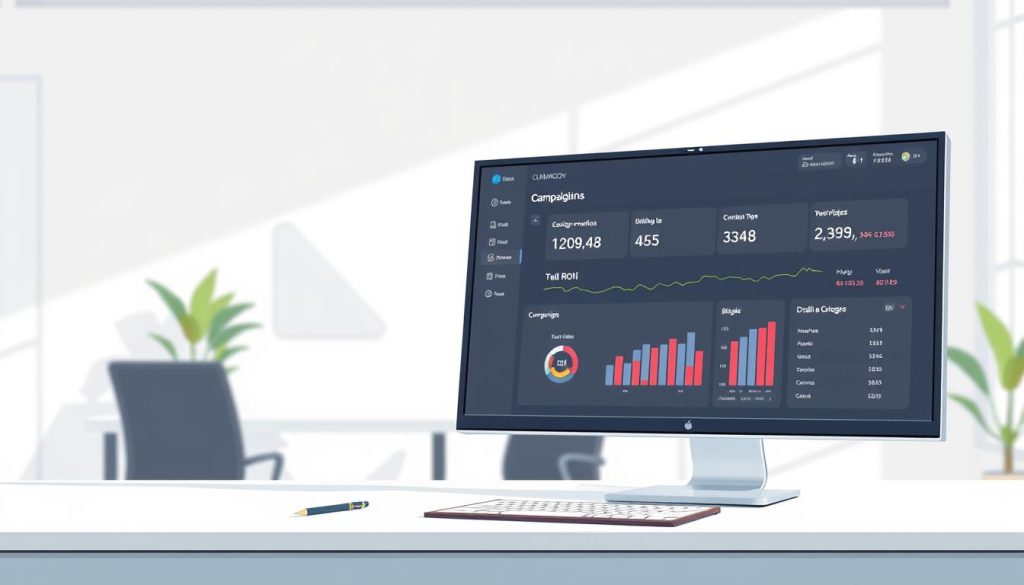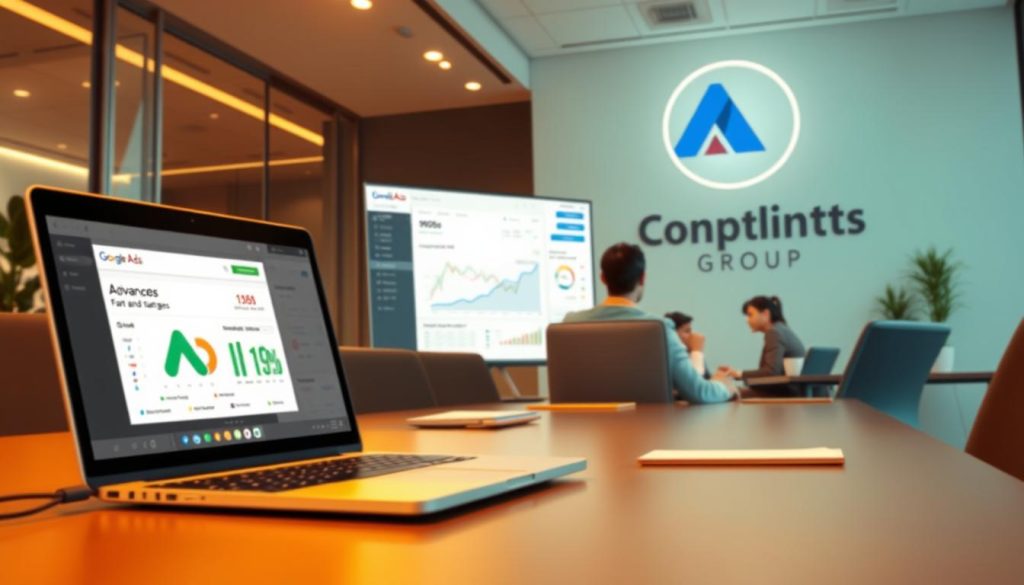Did you know that 75% of people searching online never look past the first page of results? This single fact reveals the immense pressure for visibility in today’s digital marketplace. If your business isn’t appearing prominently, you’re missing a massive opportunity to connect with potential customers.
The good news is that paid advertising platforms, like Google Ads, offer a powerful solution. They allow you to place your message directly in front of people actively searching for your products or services. However, success isn’t just about having the biggest budget.
The system is designed to reward relevance and quality. A well-optimized campaign can actually outperform a competitor spending more money. This is why understanding how to improve your quality score is so critical. It directly impacts your ad position and cost.
This guide will walk you through the essential strategies to build campaigns that not only rank well but also deliver a strong return on investment. You’ll learn how to make every advertising dollar work harder for your business.
Table of Contents
Key Takeaways
- Most searchers (75%) do not go beyond the first page of results, making top ad placement crucial.
- Paid search platforms prioritize ad relevance and user experience, not just the highest bid.
- A high quality score can significantly lower your costs and improve your ad positioning.
- Strategic optimization is the key to competing effectively, even with a smaller budget.
- Well-structured campaigns connect your business with ready-to-buy customers at the perfect moment.
Understanding Google AdWords Campaigns
Imagine having a powerful tool that lets you connect with customers exactly when they’re searching for what you offer. This is the core promise of modern advertising platforms. Understanding how these systems work is your first step toward marketing success.
What Are Google AdWords Campaigns?
Think of your advertising efforts as a well-organized filing system. At the highest level sits your main account. This central hub manages everything and can even grant access to marketing partners.
Within your account, you create separate initiatives for different goals. Each initiative contains groups of related promotional messages. These groups share the same budget and target audience.
| Level | Purpose | Components |
|---|---|---|
| Account | Central management hub | All initiatives, budget control, access settings |
| Campaign | Specific marketing goal | Budget, geography, schedule, ad groups |
| Ad Group | Theme-based organization | Related ads, keywords, targeting parameters |
Evolution from Adwords to Google Ads
The platform has grown significantly since its early days. What began as a simple text-based system now offers diverse advertising options across multiple channels.
The transformation from a search-focused platform to a comprehensive advertising ecosystem reflects changing consumer behavior and technological advancement.
This evolution means you can now reach customers through various formats. Video content, display networks, and smart automation tools provide flexible options for different business needs.
Setting Up Your Campaign: Bid, Budget, and Objective

Your campaign’s success trajectory begins with three critical decisions: what you want to achieve, how much you’ll spend, and how you’ll bid. Getting these foundational elements right from the start ensures your advertising efforts deliver maximum value.
Selecting the Right Advertising Objective
Your campaign objective defines your primary goal. Are you seeking website traffic, lead generation, or brand awareness? Each objective aligns with different business needs.
For e-commerce businesses, conversion-focused objectives drive sales. Service providers often prioritize lead generation. New brands typically choose awareness objectives to build recognition.
The platform offers clear objective categories: Traffic, Conversion, and Awareness. Your choice determines which campaign types and features become available.
Managing Your Bid and Budget Effectively
Budget control is straightforward. You set daily or monthly limits that prevent overspending. These can be adjusted anytime based on performance.
Manual cost-per-click bidding means you only pay when users click your ads. This ensures your budget drives actual visitor traffic.
Remember, your budget isn’t the only factor in ad placement. The system also evaluates ad quality and relevance. A high quality score can help you achieve better positions at lower costs.
The setup process includes helpful notifications about potential issues. The navigation menu provides a clear overview of your progress through each step.
Choosing the Right Campaign Type for Your Business
Different advertising goals require different campaign approaches for optimal results. Your choice determines where your message appears and who sees it. Understanding the available options helps you make informed decisions.
Search, Display, Video, and More
The platform offers several campaign formats designed for specific marketing objectives. Search campaigns show text ads to people actively looking for your products. These are perfect for capturing high-intent customers.
Display campaigns use visual ads across millions of websites and apps. They excel at building brand awareness and remarketing. Video campaigns tell your story through engaging content on platforms like YouTube.
Matching Campaign Types with Marketing Goals
Each campaign type serves a distinct purpose in your advertising strategy. Retailers benefit from Shopping campaigns that showcase product listings. Performance Max campaigns use AI to find customers across all channels.
The key is aligning your campaign format with your primary objective. Immediate conversions work best with search campaigns. Brand building pairs well with display or video formats.
| Campaign Type | Best For | Ad Format |
|---|---|---|
| Search | High-intent customers | Text ads |
| Display | Brand awareness | Image ads |
| Video | Storytelling | Video content |
| Shopping | Product sales | Product listings |
| Performance Max | Maximizing reach | Multiple formats |
Many businesses use multiple campaign types simultaneously. This creates a comprehensive strategy that covers different customer journey stages. The platform often recommends the best options based on your chosen objectives.
Optimizing Your Ads and Targeting Strategies
Great campaign setup is just the beginning—optimization turns good performance into exceptional results. This is where you transform basic advertising into a high-performing machine that delivers qualified traffic while controlling costs.
Refining Ad Copy and Creative Assets
Your text ads for search results need compelling headlines that directly address user queries. Focus on highlighting your unique value proposition and including clear calls-to-action.
The quality of your ad copy dramatically affects your quality score. Well-written text ads that are relevant to keywords and landing pages deliver better performance at lower costs.
Testing multiple ad variations is essential for optimization. Create different headlines and descriptions, then let the platform automatically show the best-performing versions more often.
Leveraging Targeting Options for Better Performance
Smart advertisers organize their ads search efforts into tightly themed groups. All keywords, ads, and landing pages should be closely related for maximum relevance.
Instead of buying hundreds of broad keywords, focus on specific « long tail » terms that match what ideal customers actually search for. This strategic approach often delivers better results at lower costs.
Modern targeting options allow sophisticated audience segmentation. You can reach users based on:
| Targeting Type | Best Use | Key Benefit |
|---|---|---|
| Remarketing | Previous visitors | Higher conversion rates |
| Similar Audiences | New prospects | Expanded reach |
| Demographic Targeting | Specific customer profiles | Precise messaging |
Your landing page plays a crucial role in ad optimization. Ensure each ad group directs users to a page that directly addresses the promise made in your text ads search results.
Remember that optimization isn’t a one-time task. It’s an ongoing process of analyzing performance data and refining your approach to steadily improve return on investment.
Advanced Strategies for Google AdWords Campaigns

Ready to take your advertising results to the next level? Advanced techniques can dramatically improve your advertising performance and maximize your return on investment.
Utilizing Performance Max and AI Optimization
Performance Max represents a powerful approach that uses artificial intelligence to optimize your advertising across multiple channels. This smart system automatically finds high-value customers wherever they engage online.
The AI analyzes user behavior in real-time to show your ads at the perfect moments. You provide quality creative assets and conversion goals, then the system handles the optimization.
Focus on supplying diverse, high-quality images, video content, and compelling text. The AI combines these elements to create thousands of ad variations, testing what resonates best with different audience segments.
Insights on Keyword Targeting and Audience Segmentation
Sophisticated keyword strategy goes beyond basic search terms. Analyze search query reports to discover unexpected long-tail keywords that convert well. Add negative keywords to prevent wasted spend.
Advanced audience segmentation allows you to layer multiple signals. Combine remarketing lists with customer match and similar audiences for precise targeting.
For product-based businesses, optimize your product feed with detailed descriptions and high-quality images. Local inventory ads can promote items available at physical locations.
Video content on platforms like YouTube has evolved beyond brand awareness. Action-focused video campaigns can drive conversions while telling compelling brand stories.
Many successful advertisers partner with specialized agencies who can provide expert strategy and continuous optimization. Sometimes the smartest approach is bringing in professionals who live and breathe paid advertising.
Conclusion
As we wrap up our exploration of digital advertising strategies, it’s clear that success hinges on more than just budget allocation. The right approach connects your business with ready-to-buy customers, delivering measurable results that impact your bottom line.
Remember that quality and relevance often outperform sheer spending power. Even smaller businesses can achieve prominent positions in search results by focusing on strategic optimization.
The time to start is now. Whether you manage your Google Ads yourself or work with experts, the key is taking that first step. Consistent testing and refinement will help you maintain strong performance over time.
Your most valuable customers are searching for solutions right now. Implementing these proven strategies positions you to capture their attention and drive real business growth through effective advertising.
FAQ
What are the main types of campaigns available?
You have several options to reach your audience. The main ones include Search, Display, Video, Shopping, and Performance Max. Search text ads appear in search results. Display uses image ads on websites. Video campaigns run on YouTube. Shopping shows product listings. Performance Max is a smart option that uses automation across all Google networks to meet your goals.
How do I choose the right campaign type for my business?
Start by thinking about your primary advertising objective. If you want to drive sales for specific items, a Shopping campaign is great. To increase brand awareness with visuals, consider Display. For generating immediate leads or website visits, Search campaigns are highly effective. Matching your marketing goals to the campaign’s strengths is the key to success.
What’s the difference between bidding and budgeting?
Your budget is the total amount you’re willing to spend over a given time, like per day. Bidding is the strategy you set for how much you’ll pay for a specific result, such as a click or a conversion. You manage your budget to control overall costs, while your bidding strategy helps you compete in auctions to get those results efficiently.
How can I improve my ad’s performance?
Focus on two main areas: your ad copy and your targeting. Write clear, compelling text that speaks directly to your customers’ needs. Use high-quality images or videos for visual campaigns. Then, refine your targeting by selecting the right keywords, audiences, and demographics to ensure your ads are seen by the most relevant users.
What is Performance Max, and when should I use it?
Performance Max is a goal-based campaign type that uses Google’s AI to optimize your ads across its entire network, including Search, YouTube, Gmail, and more. It’s best used when you have a clear conversion goal, like online sales or lead generation. The system automatically finds the best opportunities to get you those results.





